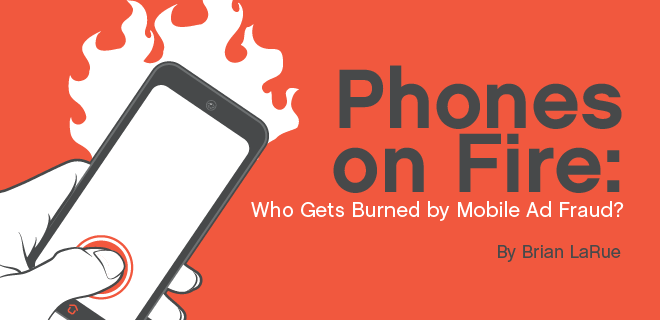
A new report from fraud detection company Forensiq sounds the alarm on widespread and ostensibly new forms of mobile ad fraud. But a closer look at how advertisers are getting bilked shows that first responders here need to be not brands, but publishers and other app providers.
Forensiq’s report does detail some sinister behavior, some symptoms of a very real ailment in digital. The ostensibly new part is what the report calls “mobile device hijacking.” The way it works is, users download mobile apps from legitimate app retailers. But the troublemaker apps end up running constantly in the background on the user’s device, emulating human behavior.
While the apps are backgrounding, they’re continually loading ads at a rate of 700 per hour, according to the report. Of course, there’s no way for the user to actually view these ads while the app is hidden. The report estimates 10%-20% of the ads displayed in these kinds of apps are visible, which means the remainder represents pure waste for advertisers. On the one hand, the result is a data and battery drain for the user. On the other, the report estimates up to $857 million of wasted ad spend per year, affecting 13% of pre-bid inventory in apps.
But here’s the catch: The malicious apps we’re talking about are garbage. They’re expressly designed to load ads that will never be viewed, and they give the user a pretty crappy experience overall. Those aren’t characteristics of premium apps. Reputable brands shouldn’t be buying their inventory in the first place. Seriously, is it so surprising that you’d buy into a fraudulent property and end up losing a good chunk of your investment to fraud?
Of course, we know why advertisers, against their better judgment, manage to buy inventory in crapola apps like these: It’s easy, it’s cheap, and there’s a lot of it. Mobile programmatic is a fast-growing market, as direct sales have proven ineffective in monetizing mobile. Marketers know they need to buy in this expanding space, but they’re not so interested in buying direct. They’re interested in buying via programmatic. But they’re not exercising proper oversight or due diligence, and they’re catching a lot of bad inventory in their nets.
There’s too much at stake to just hang advertisers out to dry. If advertisers come to expect buying mobile programmatic necessarily means buying crap inventory and losing spending to fraud, they’ll insist on paying less. That’ll drive down the already low price of mobile inventory — and that would hurt publishers more than anyone else. The onus is on publishers now to lead advertisers toward premium inventory that gives them value, while continuing to let them buy in the format they want (programmatic, in this case).
The mobile market continues to expand, and in theory, the value for advertisers to find there is real. The key is for publishers to nudge advertisers away from the bad actors in the mobile space, and the way to do that is through private exchanges and programmatic native.
Via a private exchange, publishers put a fence around inventory they know to be premium, a landscape where engagement is real and fraud is not a problem, and they allow advertisers to buy into that area programmatically. Sure, buyers in private exchanges need to set up Deal IDs, but that’s a relatively small quirk for the benefits of buying at scale in a trustworthy environment.
Programmatic native offers another way of separating the wheat from the chaff: In order to implement it, both the buy side and the sell side need to be up to date on OpenRTB 2.3, and at least for the time being, a lot of those garbage apps aren’t. This iteration of OpenRTB works well with in-feed units, which advertisers hold particularly desirable in mobile. Publishers ought to take advantage of what this standard can add to mobile revenue.
We know advertisers are eager to buy in mobile, but publishers can’t take that eagerness for granted now. If advertisers expect the inventory they’re buying is going to be full of trash that never gets viewed, the same thing that happened to desktop display is going to happen to mobile: They’ll aim for the cheapest inventory, targeting around just a few rough aspects, and as a result the price of mobile inventory at large will sink.
It doesn’t have to be this way. Widespread fraud shouldn’t be considered a force of nature or a necessary cost of doing business in mobile. But for advertisers to get the picture, publishers will need to paint it first.